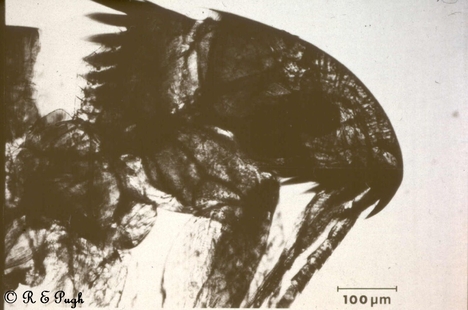Taxonomy: Order Siphonaptera (fleas)
Animal: Ctenocephalides felis felis 15a.jpg
Sites: Skin
Comment:
Head of Ctenocephalides felis felis (cat flea) cf. Ctenocephalides canis (dog flea) 13.jpg. Cat flea has a long pointed head cf dog flea which has a rounded head and a small first genal comb. The cat flea is the most common, widespread nuisance flea of cats, dogs and humans world-wide as well as of many other animals. Apart from causing severe allergic reactions, C. felis felis is the intermediate host for Dipylidium caninum (the double pore dog tapeworm), and can also act as an IH for Hymenolepis nana and can transmit diseases such as the plague and murine typhus. Although designated the cat flea, it lives on both cats and dogs as does the dog flea, C. canis but in Australia, C. felis felis is more common in warmer areas living on the blood of both dogs and cats and C. canis is more prevalent in more temperate areas - they are the only species of Ctenocephalides in Australia. There are 3 other subspecies of Ctenocephalides felis - strongylus, orientis, damarensis (Jordan, 1943 IN Smart 1943 see bibliography). Ctenocephalides are 1-3 mm long, reddish-brown to black in color, wingless, and are laterally compressed, have eyes, horizontal genal comb, pronotal comb and the mandibles are slender with inconspicuous serrations. Identification of flea species is determined by the shape of the head, presence or absence of genal and pronotal combs, eyes, internal rod on the mesothorax, bristles on hindcoxa etc. (see Pugh 1985 PhD thesis; Smart. 1943 - bibliography for details; also Roberts FHS 1952 Insects affecting livestock. Angus & Robertson,Sydney; Amin OM 1976 J Med Entomol 13: 179-192)
First Picture |
Previous Picture |
Next Picture |
Last Picture

